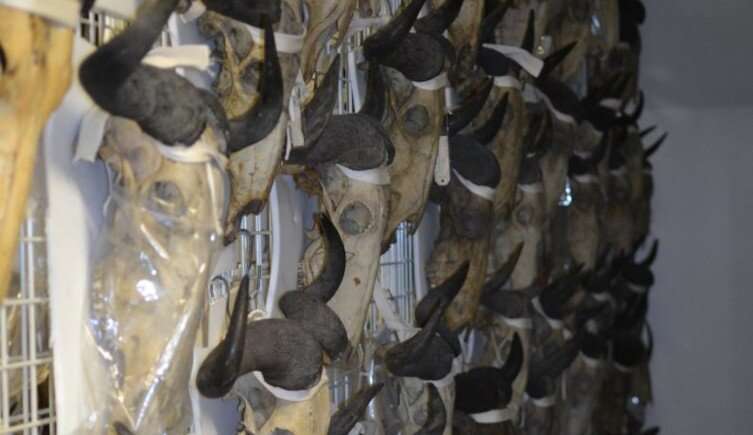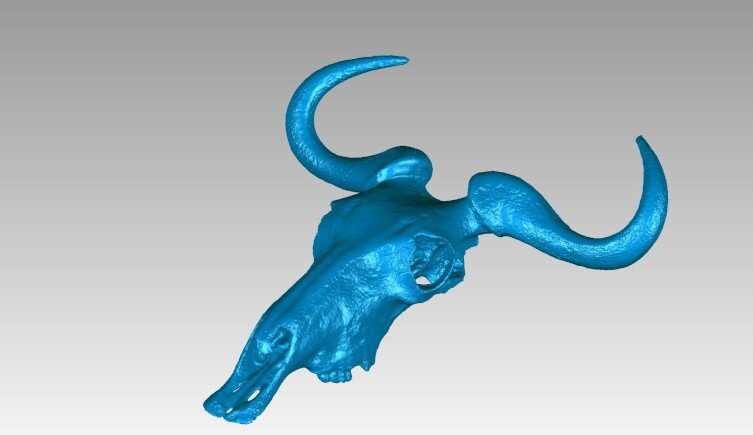Credit: CC0 Public Domain
The hallmarks of sexual selection can be found in some animals long after they have died.
Researchers using the Natural History Museum's collection found that wildebeest skulls showed signs of adaptation for competition—a finding that could help uncover similar features in extinct species.
Female wildebeest are engaged in an evolutionary arms race—but scientists aren't sure why.
Researchers studying blue wildebeest skulls found that sexual selection is driving the development of horns in both males and females. Surprisingly, when the growth of both sexes was accounted for, there was no significant difference between the shape of their horns.
While males make use of their horns to compete with each other, it's currently uncertain why the horns of females provide an evolutionary benefit. This may reflect wider issues over the historic lack of study of female animals by biologists compared to males.
Dr. Andrew Knapp, a Museum scientist who co-authored a study detailing these results, says, "This is an interesting finding because it's not what we might expect. Male and female horns are growing in a characteristic way that indicates sexual selection, but they're not being used for the same thing."
"While males use their horns to compete for mates, we don't know what females use them for. There are a few theories, but nothing certain."
The findings of the study, published in BMC Ecology and Evolution, also suggest that sexual selection could be detected in extinct organisms, but that telling different sexes apart is not always obvious.
What are secondary sexual traits?
The horns of wildebeest are an example of a secondary sexual trait, which are characteristics that are not directly involved in the reproductive process but can have an influence on it.
Blue wildebeest skulls from the Museum's collection were used in the study. Credit: Andy Knapp
Traits such as the tail of a male peacock, or the inflatable membrane of a hooded seal, can demonstrate the health or virility of an individual to potential mates and competitors.
Where these signals are directly linked to the health of an individual, or take a lot of effort to produce, they are considered 'honest signals' because they are difficult or unrewarding for weaker animals to fake them.
This means these characteristics show distinctive growth patterns that should be visible in both living and extinct organisms.
"Features such as horns which are used for display exhibit a characteristic known as positive allometry, where larger animals have proportionally bigger traits," Andy explains. "Male bovids all have these traits, but so do around half of females."
"These traits are under strong selection in males to help them compete, so in females we would expect there to be a substantial difference in this pressure."
The researchers investigated whether this pattern could be observed using 75 blue wildebeest skulls, with the vast majority coming from the Museum. Each skull was digitized, with its dimensions being used to calculate its precise 3D shape.
When shape alone is considered, there is a clear distinction between the horn shape of males and females, with both sexes demonstrating a shared allometry. However, these differences disappear when corrected for size.
"When you look at the distribution of the data, a small male looks to all intents and purposes like a female," Andy says. "All the animals pass through the same size range, but females generally don't grow to the largest end of the spectrum."
It suggests that males only have distinctive horns because they tend to grow larger than females, and that the horns of both sexes experience similar levels of selection.
It has been suggested that selection for female horns could relate to predator defense, fighting other females, or even male mimicry, but the evidence for these theories is currently limited.
The skulls were digitised to measure the 3D shape of each individual's skull. Credit: Andy Knapp
Can sexual selection be detected in extinct animals?
While this paper provides new lines of research for scientists studying living animals, it also offers opportunities for researchers studying extinct species.
Identifying the sex of extinct species is notoriously difficult, especially in animals such as the dinosaurs. A lack of fossils, which are often incomplete, makes it hard to identify if an individual was male or female.
Factors which scientists studying living animals could use, such as sexual dimorphism, are often complicated by overlaps in body size and other characteristics.
Only very unambiguous features such as the presence of preserved eggs within the womb or features with direct parallels to living animals, such as the antlers of Megaloceros, can help to identify an individual's sex.
It is similarly difficult to identify a feature which is undergoing sexual selection as other roles, such as species identification, could also explain their rapid evolution. The new research, however, can help add to arguments for or against a feature being used in this way.
"It's entirely possible to use this technique to examine extinct animals," Andy says. "I've been involved in previous work that found a very similar pattern to the wildebeest horns in the frill of Protoceratops, a dinosaur around the size of a sheep."
"The findings of this study suggest that we can't rule out sexual selection as an explanation for these patterns, even if we can't distinguish between the sexes."
For now, however, Andy is returning to the land of living species. He and a colleague are examining the evolution of horn shape across bovids to see if sexual selection has led to the rapid development of these characteristic features.
More information: Chloé Gerstenhaber et al, Sexual selection leads to positive allometry but not sexual dimorphism in the expression of horn shape in the blue wildebeest, Connochaetes taurinus, BMC Ecology and Evolution (2022). DOI: 10.1186/s12862-022-02060-3
Journal information: BMC Ecology and Evolution
Provided by Natural History Museum
This story is republished courtesy of Natural History Museum. Read the original story here.


























